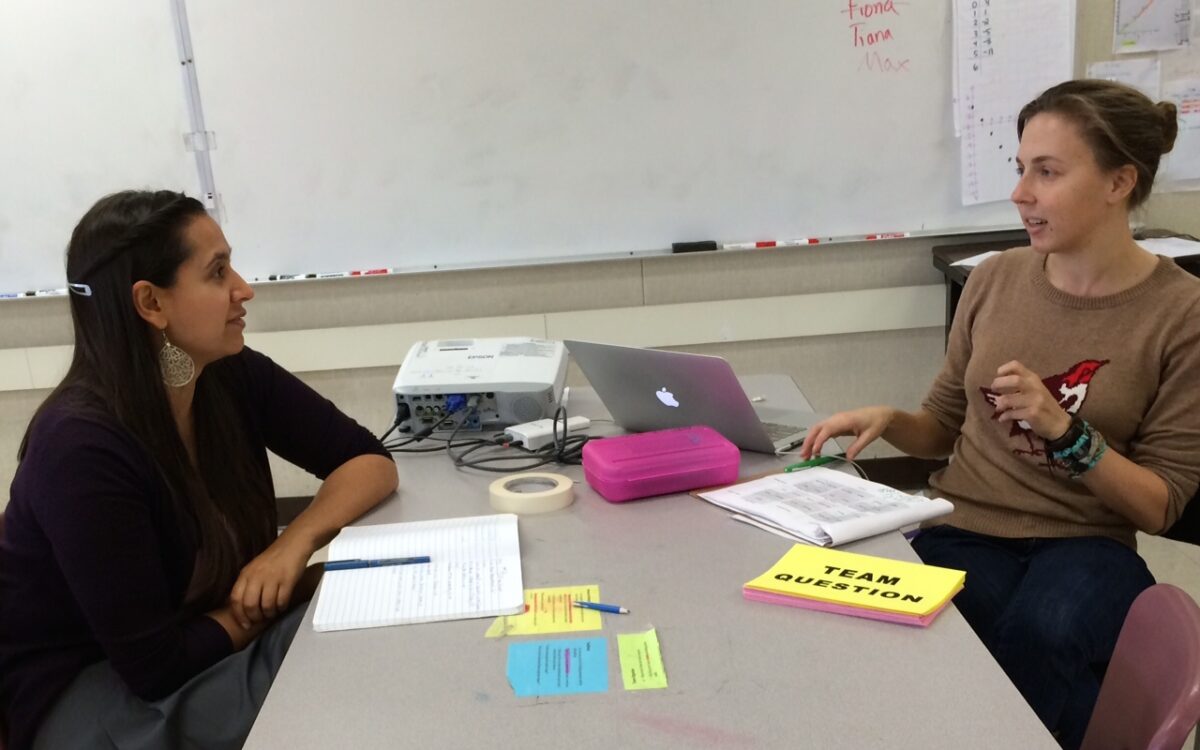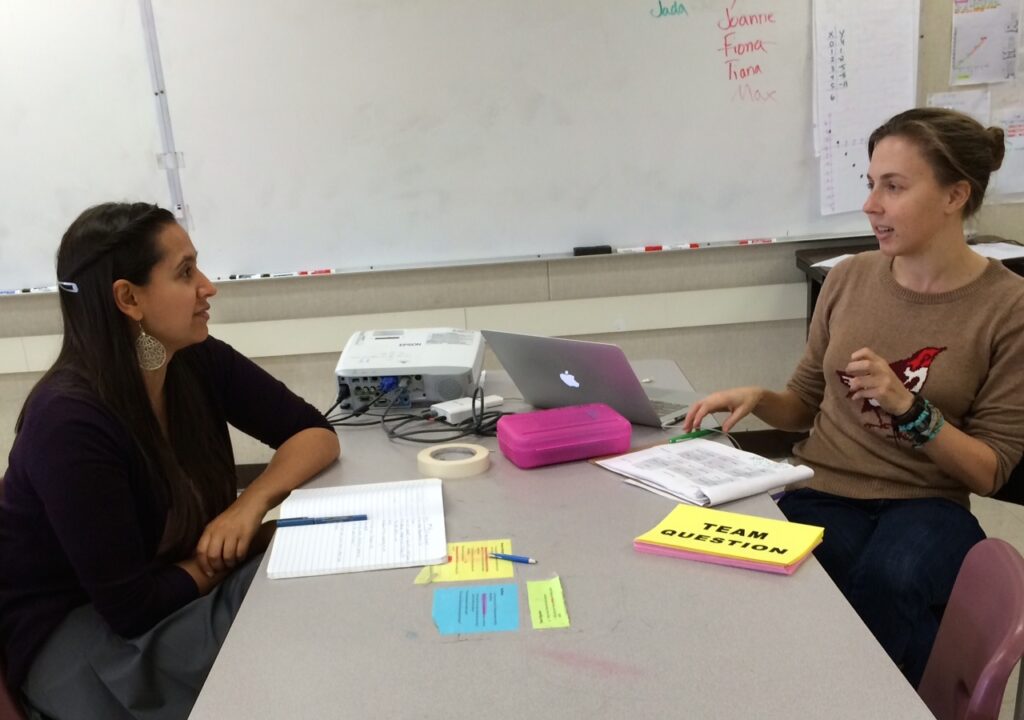Classroom coaches critical as teachers shift to Common Core
 Laurie Udesky/EdSource Today
Laurie Udesky/EdSource Today
Oakland charabanc Geetha Lakshminarayanan on the left debriefs with instructor Johanna Langill in her classroom.
 Laurie Udesky/EdSource Today
Laurie Udesky/EdSource Today
Oakland bus Geetha Lakshminarayanan on the left debriefs with teacher Johanna Langill in her classroom.
To pause down the isolation that many teachers experience in their classrooms, California schools are using instructional coaches every bit a key tool to assistance teachers adapt their instruction to implement the Common Core standards in math and English language language arts.
Enter Geetha Lakshminarayanan, a math coach who on a recent mornwas making her weekly visit to Oakland Technical High School and watching closely to encounter how students were grappling with exponential equations in Johanna Langill'due south Algebra 1 class.
Districts have used coaches – more than formally known every bit instructional or training specialists – for years to amend the effectiveness of classroom instruction. Many coach positions were trimmed as a result of cutbacks during the Smashing Recession. Simply with the improving economy and the need to get teachers upwards to speed on the new Mutual Cadre standards, districts are turning to instructional specialists equally an essential resource.
Now, their help and grooming is needed more than always as teachers make the radical shifts in instruction set by the Common Core Country Standards, the new academic guidelines for what students should know at each course level in math and English Language Arts.
A survey by EdSource of six California districts – Garden Grove Unified, Santa Ana Unified, Whittier Matrimony High School District, Visalia Unified, Oakland Unified and San Jose Unified – showed that all are relying on coaches every bit they motion forward to implement the Mutual Cadre.
Oakland Unified, with an enrollment of over 37,000 students has between 45 and 50 coaches who are each assigned to work total time at a particular school. That'due south double the number from 3 years ago, said Nicole Knight, the district's interim co-director of teaching and learning
Lakshminarayanan is ane of an additional 35 coaches who specialize in different subject areas and move from school to schoolhouse. She works with six to eight teachers each calendar week at ii different schools. She and the other coaches assistance out in a number of means by observing classes, giving feedback to teachers during or outside school hours, responding to teachers' questions by email or giving demonstration lessons.
Next year, the commune intends to reduce the number of coaches that travel to different schools and add xx Common Core coaches assigned to specific schools, Knight said. Coaches at Oakland Unified are funded by a combination of land funds districts receive through the Local Control Funding Formula, grants from the S.D. Bechtel Jr. Foundation, federal Title Two funds for teacher and principal preparation and Title III funding for English learners.

Johanna Langill teaches math at Oakland Technical High Schoolhouse
Other districts have to manage with far fewer coaches. At Visalia Unified, a 27,000-pupil district about Fresno, a single coach is assigned to serve all teachers in each uncomplicated grade. A total of iv coaches work with teachers in 7th- to twelfth-class classrooms. Sacramento City Unified, with 43,000 students, has 12 math coaches, each of whom is assigned to five or six schools. Just that number is up from only ii coaches in 2010-11.
"We have grown the number of coaches each year, but we definitely demand more of them," said Iris Taylor, the district's assistant superintendent for curriculum and didactics. The coaches, she said, "are the well-nigh critical component of our capacity building [to implement the Common Core].
These specialized instructors, she said, "are able to provide a more in-depth and stronger layer of support, and are able to work with more teachers than we are able to touch through professional person evolution sessions alone."
Without coaches like Lakshminarayanan, teachers may non know for certain if they're getting the new Common Core approaches to math teaching right, said Robert Rosenfeld, manager of the curriculum and assessment training team at WestEd, the nonprofit research and consulting house headquartered in San Francisco.
"Until you actually endeavour it out with students and accept a thought partner (such as a coach) to give you feedback, we don't meet any meaningful changes in the classroom," he said, referring to the need for coaches. "With the Mutual Core there are so many things nosotros're expecting to see in the classroom, you actually need a guide."
Lakshminarayanan observedhow Langill was helping her students appoint with each other past request them how they arrived at their answers on their homework assignments.
In the back of the classroom, she quietly debriefed an EdSource reporter about what she was seeing. She explained that she was looking at how students approached the math trouble. Are they talking among themselves about the consignment? They should be. If non, what is Langill doing about it? If then, what are they saying to each other?
"With the Mutual Core there are and then many things we're expecting to encounter in the classroom, y'all actually need a guide," said Robert Rosenfeld, director of the curriculum and assessment grooming team at WestEd.
She referred to a student in a red and white plaid shirt who was talking to Langill.
"I just saw that student ask Miss Langill a question and before she fifty-fifty started responding to him, she pulled in the other 2 students [into the dialog]," Lakshminarayanan whispered. "That was a good move. He [the student] should ask the other kids first and they need to also pay attention and talk to each other."
In gild to successfully impart the Mutual Cadre standards, math teachers' roles are irresolute substantially, Lakshminarayanan said. Teachers should deed more than like facilitators of discussion and contend rather than an instructor with all the answers, she said.
A former Oakland high school math teacher, Lakshminarayanan left classroom teaching 2 years agone to become a coach, and the district provided a week of training in the summer, plus ongoing grooming every other calendar month. Additionally, the district has brought in experts on various Common Core math topics that she and beau math coaches request, and Lakshminarayanan meets for about three hours each month with boyfriend math coaches. During the meetings, coaches take turns training one another in the areas within which they have expertise, she said.
Ane of the eight Mutual Core "Standards for Mathematical Practice" that applies to all grades is that students "construct feasible arguments and critique the reasoning of others." Every bit a event, students are expected to exist active conversationalists in the classroom.
To encourage students to appoint each other in such conversations, teachers implementing the Common Core typically assign students to sit down in small groups. In Langill'due south course, she'due south assigned "facilitators" to each group. Those are students whom she hopes will take the lead in prompting discussion amongst their classmates.
In some cases, the initial groupings don't always work out as she had thought they would. In her coming together with Lakshminarayanan after class, Langill shared her concerns about the different groups. In one grouping, there wasn't enough interaction.
In another, the designated student "facilitator" seemed to only exist communicating with the girls sitting on either side of her, instead of the entire group.
Lakshminarayanan had also noticed the lack of communication, and wondered if the girls who weren't participating couldn't hear the facilitator or merely were resigned to thinking that they were not going to exist included in the discussion.
She suggested to Langill that a simple solution might exist to change the seating arrangement.
San Jose Unified Assistant Superintendent Jason Willis said that before the Mutual Core was introduced, in math at the unproblematic school level "a lot of content was scripted, you kind of read from the book," and it drilled students on things like multiplication tables.
To assist teachers adjust to the new Common Core standards, his district has as well assigned a motorbus to each class level. Last year, some schools had part-fourth dimension instructional coaches. This yr, about of the uncomplicated schools use full-fourth dimension coaches. Additionally, x coaches who accept been working with middle and high school teachers over the last five years are now helping them settle into the new standards.
Lakshminarayanan, who has been observing Langill's classes since the beginning of the schoolhouse year, said she'south witnessed critical changes in Langill's algebra form. "I come across kids relying more than on each other and on their own reasoning instead of Miss Langill," Lakshminarayan said. "They know that when she comes over she's going to enquire them more questions, she's not going to tell them how to practice it."
For Langill, Lakshminarayanan's input has been invaluable. "It's made such a deviation," Langill said. "Sometimes it'south just talking through successes and what is frustrating me that can help me identify what kids need next and what I can practice to run across those needs," she said of her interactions with Lakshminarayanan. "Information technology helps me see the progress that I accept made and kids have made."
To get more reports like this ane, click here to sign up for EdSource's no-cost daily email on latest developments in educational activity.
schweitzertaintimand.blogspot.com
Source: https://edsource.org/2015/classroom-coaches-critical-as-teachers-shift-to-common-core/73730
Post a Comment for "Classroom coaches critical as teachers shift to Common Core"